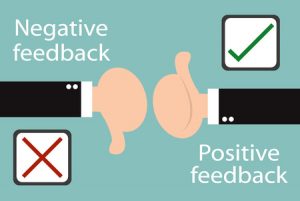Feedback is important. It is the information that we need to be able to improve our performance, whether that is the work we are doing day-to-day, or the work we are doing to gain new qualifications.
It comes in various forms too, including written responses to work completed, to grades, peer reviews and other formal measures.
It can also be informal – for example, when given a presentation, if the faces of your audience register disinterest, they are feeding back that you are not quite hitting the mark.
Feedback can be both positive and negative. Modern appraisal methods will often try to incorporate the two. For example, formal feedback may list positive comments or points, as well as developmental issues or concerns.
There are times when feedback can be wholly negative, a situation that is disheartening. Feedback is no longer about marking with a red pen, placing crosses and question marks against sentences or concepts a student is grappling with.

Reflecting on feedback in an efficient and effective way doesn’t happen overnight.
As part of managing feedback, students also need to be taught how to use it, and to their advantage too.
Three Types of Feedback
How to give feedback and what to feedback to students are arguments as old as education itself. Opinions and ideas vary; discussions are ongoing. But two Harvard law professors, Douglas Stone and Sheila Heen, suggest that knowing what kind of feedback is needed is the starting point.
They go on to suggest that there are three types of feedback students need:
- Appreciation – this style of feedback acknowledges, give credit or thanks for what the student has achieved.
- Coaching – this style helps the student to fine tune skills, tweak understanding, increase knowledge and improve the relationship between student and tutor.
- Evaluation – this style effectively scores or marks the student’s work against a pre-determined set of criteria or standards.
Making Sense of Feedback
Managing feedback means understanding what it means to you, as a student. There are many ways of doing this but essentially, they all involve the student reflecting on what is being said or written as they receive it.
#1 Reflection
Reflective practice is not only used in schools and colleges but across a whole swathe of learning and development. Practitioners such as counsellors and therapists use reflective practice to understand how or why they are reacting or responding in such a way.
Reflecting on feedback is important. Using all three of the styles above, how well did you receive or use the last set of feedback you received? This could be feedback on a tutor marked essay you completed or feedback from your sporting coach.
#2 Individual Response
Negative feedback – criticism – can be hard to take. Some people seem unfazed by criticism of their performance, but other students take it personally.
This is because some people need to have a context frame to their feedback. That is, tell them first what they are doing well and then make suggestions how to improve on a certain aspect.
Teaching courses focus on how to give feedback, the current ways of imparting information and this includes context setting.
In high schools, for example, the ‘two stars and a wish’ approach has been in use for some time. This is where student’s peer assess work, or their own work, by noting two things that work well and one thing that they felt needed improving upon. This is context feedback and assessment.

Some people seem unfazed by criticism of their performance, but other students take it personally.
Not all activities are marked, scored or evaluated in the same way. But, students may be unaware of this.
They may be accustomed to receiving feedback in a certain way but when it arrives in a different style, it can be disconcerting.
Stone and Heen suggest that, as part of helping students to reflect and work with feedback, they need to know how this feedback will arrive for a certain piece of work. Will it be a score accompanied by a small amount of feedback? Or will it come in the shape of a longer piece of text, or will the feedback be delivered verbally?
Takes Practice
Reflecting on feedback in an efficient and effective way doesn’t happen overnight. Students may still complain of disparities and unfairness; they may still feel that criticism is harsh and unnecessary.
Pleasant feedback is always good to hear, but is it providing enough basis for the student to move on?
Either way, providing students with useful feedback is an important part of the learning process. How could you improve the giving and receiving of feedback?
If you want to start your journey becoming a teacher and building the skillset, online teaching assistant courses are a great way to go!








